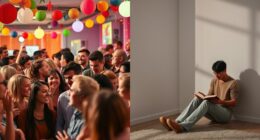Color tests give you a quick, visual way to explore personality but often lack scientific accuracy. They rely on personal perceptions and mood, which can skew results and don’t provide a stable picture. In contrast, the Big Five uses well-researched questionnaires to measure five core traits—offering more reliable and consistent insights. If you want a clearer understanding of human personality, exploring the differences further can help you see the strengths and limits of each approach.
Key Takeaways
- Color tests rely on quick, intuitive responses and subjective perception, whereas the Big Five uses validated questionnaires for reliable results.
- The Big Five measures five stable personality traits scientifically, while color tests are more casual and influenced by mood and cultural factors.
- Color tests lack scientific rigor and consistency, making them less dependable for accurate personality assessment compared to the structured Big Five model.
- The Big Five provides comprehensive, research-backed insights into personality, whereas color tests mainly serve as self-reflection or conversation starters.
- For rigorous, objective evaluation, the Big Five is preferred; color tests are better suited for casual, informal insights.

Color tests have long been used as a quick and intuitive way to evaluate personality traits, but their effectiveness compared to established models like the Big Five remains debated. When you take a color test, you’re engaging in a form of personality appraisal that relies heavily on your visual perception. Unlike structured questionnaires, these tests prompt you to interpret colors, which are believed to reveal subconscious traits or emotional states. The idea is that your choices reflect underlying aspects of your personality, such as openness, extraversion, or emotional stability. However, because color perception can be influenced by many factors—such as mood, lighting, or even cultural background—the reliability of these tests is often questioned. Furthermore, the subjectivity of color perception can lead to inconsistent results that don’t accurately represent stable personality traits. Your visual perception plays a critical role in how you respond to color tests. For instance, the shades you prefer or avoid might be shaped by your current emotional state or personal experiences, not necessarily stable personality traits. This makes color tests inherently subjective. They offer quick insights, but they lack the consistency and scientific rigor of extensive personality assessments like the Big Five. The Big Five, on the other hand, relies on well-validated questionnaires that measure five broad dimensions—openness, conscientiousness, extraversion, agreeableness, and neuroticism. These dimensions are backed by decades of research and are designed to produce reliable, comparable results across different contexts and populations. While you might find color tests engaging and fun, they often don’t provide the depth or accuracy needed for serious personality analysis. They can serve as conversation starters or self-reflection tools, but they shouldn’t be used as the sole basis for understanding someone’s personality. In contrast, the Big Five offers a structured framework, grounded in empirical evidence, that captures the complexity of human personality more effectively. When you’re evaluating personality through a scientific lens, the structured approach of the Big Five tends to outperform the quick, intuitive impressions you get from color tests.
Frequently Asked Questions
How Do Color Tests Assess Personality Traits Differently From Big Five?
Color tests assess your personality by examining color symbolism and emotional interpretation, revealing how you respond to different hues. You’ll choose colors that resonate with your feelings, providing insight into traits like openness or extraversion. Unlike the Big Five, which measures traits through structured questions, color tests tap into subconscious associations and emotional reactions, offering a more intuitive understanding of your personality based on your color choices.
Can Color Tests Reliably Predict Behavior Compared to Big Five Assessments?
You might be surprised, but only about 35% of color tests reliably predict behavior, unlike the Big Five’s 80% accuracy. Color psychology influences your visual perception, making color tests more intuitive but less precise. While they can hint at personality, their predictions aren’t as consistent or detailed as Big Five assessments, which analyze traits systematically. So, for accurate behavior insights, the Big Five remains more dependable than color tests.
What Cultural Factors Influence Color Test Results More Than Big Five?
Cultural symbolism and regional color associations influence color test results more than Big Five assessments. You might find that people interpret colors differently based on their cultural backgrounds, affecting the test outcomes. For example, red may symbolize luck in some cultures but danger in others. These cultural factors shape how you perceive and respond to colors, making color tests more susceptible to cultural biases than the more stable traits measured by the Big Five.
Are Color Tests More Suitable for Quick Personality Insights Than Big Five?
Color tests are more suitable for quick assessments and intuitive insights than the Big Five. They offer a fast, engaging way to get a general sense of personality traits without the extensive analysis required by the Big Five. If you’re looking for immediate understanding or a fun, informal approach, color tests can be effective. However, for detailed, reliable insights, the Big Five remains the more thorough choice.
How Do Individual Preferences Affect the Accuracy of Color Test Outcomes?
Your individual preferences can influence color test outcomes considerably. Personal bias and visual perception shape how you interpret and select colors, which can skew results. If you’re drawn to certain hues due to mood or associations, it might not accurately reflect your personality traits. Recognizing these biases helps you understand that color test results are subjective, and they should be supplemented with other assessments for a more thorough personality picture.
Conclusion
As you reflect on the parallels between color tests and the Big Five, you realize how both reveal hidden facets of your personality, much like a sunset unexpectedly painting the sky in vibrant hues. Sometimes, these tools seem to align perfectly, as if chance has woven your traits and colors together in a fleeting, beautiful coincidence. In that moment, you see yourself more clearly—an intricate mosaic of shades and traits, waiting to be explored.
Felicity, our Author, pens in-depth articles and guides that delve into the heart of personal discovery. Her narrative-driven approach weaves together theory, practice, and personal anecdotes, making the journey of self-exploration both relatable and inspiring. Felicity’s contributions help illuminate the path for those seeking a deeper understanding of themselves and their relationships.










